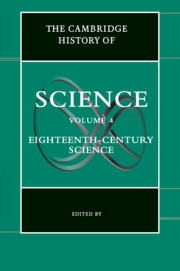Book contents
- Frontmatter
- 1 Introduction
- Part I Science and Society
- Part II Disciplines
- Part III Special Themes
- 22 Eighteenth-Century Scientific Instruments and Their Makers
- 23 Print and Public Science
- 24 Scientific Illustration in the Eighteenth Century
- 25 Science, Art, and the Representation of the Natural World
- 26 Science and Voyages of Discovery
- Part IV Non-Western Traditions
- Part V Ramifications and Impacts
- Index
- References
22 - Eighteenth-Century Scientific Instruments and Their Makers
from Part III - Special Themes
Published online by Cambridge University Press: 28 March 2008
- Frontmatter
- 1 Introduction
- Part I Science and Society
- Part II Disciplines
- Part III Special Themes
- 22 Eighteenth-Century Scientific Instruments and Their Makers
- 23 Print and Public Science
- 24 Scientific Illustration in the Eighteenth Century
- 25 Science, Art, and the Representation of the Natural World
- 26 Science and Voyages of Discovery
- Part IV Non-Western Traditions
- Part V Ramifications and Impacts
- Index
- References
Summary
“The diffusion of a general knowledge and of a taste for science, over all classes of men, in every nation of Europe, or of European origin, seems to be the characteristic feature of the present age.” So wrote James Keir (1735–1820), the pioneer industrial chemist, in the preface to his The First Part of a Dictionary of Chemistry of 1789. There can be no question that the study of the material world – then described as experimental natural philosophy – seriously impinged on the popular consciousness for the first time in the course of the eighteenth century. This was achieved by means of a remarkable social and educational phenomenon: the lecture demonstration.
Science today is understood to be the sphere of activity of the “scientist,” a term that was first coined in the 1830s by William Whewell (1794–1866), author of The History of the Inductive Sciences. The coinage marks a transition between the mainly amateur natural philosopher and the professional scientist. This is not, of course, to say that science was not studied, and used professionally, centuries earlier in Europe. What was missing in the classical Greek approach to the natural world was the use of experiment. Ideas were tested by reason alone, following the authority of Aristotle, which was broadly accepted throughout the Middle Ages. For example, Aristotle denied the possibility of a vacuum because he reasoned that bodies would move with infinite velocity, a theory that could not then be checked by experiment.
- Type
- Chapter
- Information
- The Cambridge History of Science , pp. 509 - 535Publisher: Cambridge University PressPrint publication year: 2003
References
- 4
- Cited by

